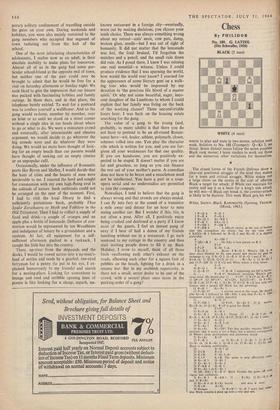Chess
By PHILIDOR No. 189. G. LATZEL (Die Schwalbe, 1956) BLACK (3 men)
WHITE (4 men) WHITB to play and mate in two moves; solution nest week. Solution to No. 188 (Trumper): Q—Kt 5, no threat. Seven distinct mates follow the seven possible Black rook moves; I leave readers to work out these and the numerous other variations for themselves.
The closed forms of the French Defence show a clear-cut positional struggle of the kind that makes for a tense and critical struggle. White stakes out a large claim on the centre at the cost of offering Black a target for attack; if White can maintain his centre and use it as a basis for a king's side attack he will win—if Black can break it, the counter-attack is likely to be decisive. This week Black gets his way.
White, SAIZEV, Black, KAPENGUTH. Opening, FRENCH.
(Minsk, 1963.)
1 P—Q 4 P—K 3 2 P—K 4 P—Q 4 3 Kt—Q 2 Kt—KB 3 4 P—K 5 KKt—Q 2 S P—QB 3 P—QB 4
6 P—KB 4 . . , A difficult choice; at the cost of further time this strengthens the centre, but for my own taste 6 Kt(Q2)—B 3 followed by B—Q 3 and Kt—K 2 is slight-1Y preferable.
6 . . . Kt—Q13 3
7 QKt—B 3 . the KKt is best placed on K 2.
7.8 P X' P . 11 x—Kt 5 ch
9 K—B 2 . . . Better 9 B—Q 2. White's QB
poor piece blocked by fiis own pawns and should be glad 10 exchange it, e.g. 9 B—Q 2, Q—R 4; 10 B—Q 3 and if 10 • • • BxB ch; II Q XB, QXQ ch (II. . Kt—Kt 5; 12 B—Kt 1
9
and 13 P—QR 3); 12 K xQ and White stands a little better.
. 0-0
10 B-Q 3 P—B 3! II Q-13 2? . . . 11 B—K 3 supporting the QP is better. II . . . P—B 4? Needlessly justifying While's Per vious move. He should play 11 P X Pt; 12 B X P ch, K—ff. ”
13 QP xP (13 BP) 12 11—K 3 Kt—Kt 3 • 13 P—Kt 4? . a suicidal move at this stage. He should play Kt—K 2 followed by QR—KKt I and then P—Kt 4. mitts premature attack is rightly punished. 13 . . . B—K 2! 14 P—QR 3 . . 14 PxP, Kt—Kt 5; KtX B ch; 16 QXkt,.) 14 . . . 15 13xP ch K—R I 16 Kt—K I Kt—B 5. Threat 17 . . . 13—R 5 ch; IS K—K 2, Kr X B; L9 K x Kt, RxP; 20 Kx R?, Q—Kt 4 mum 17 Kt—Kt 2 B—Q 2 18 Kt—K 2 B—R 5 ch 19 K—Kt 1 Kt x 20 Kt x Kt Kt xQP! This fine sacrifice smashes White's position; that it exists is not a fluke. but a natural consequence of White's tardy development and premature attack. 21 Kt >LICA 22 P—R) R xP . . . or 22 KI--K 2, Q—Kt 3; 23 Kt)(B.: QXKt eh; 24 K—Kt 2, Q—B 6 ch; 25 K—Kt I, Q x Kt and Black is winning comfortably. 22 . . . 11—B 7 eh 23 Q x13 R X Q 24 K X R P—Kt 6 ch 25 K x P K x B. The game is now effectively over' 26 Kt—B 3 Q—Kt 3 27 Kt—Kt 4 B—Kt 4 28 P—KR 4 B—K 7 • 29 Kt—Kt 5 ch K—Kt 3 30 QR—KKt I K—R 4! Black finishes the game off with vigour and confidence. 31 Kt—R 3 R—KB I. 31 . . B x Kt; 32 Kt—B 4 eh and 33 KxKl. 32 Kt—B 4 ch RxKt forced . . . and wins at once. 33 K xR B x Kt 34 Resigns . . . 34 R x B??. Q—B 7 mate and 91.her. wise Black remains a piece up with a very easy win. IS Q moves,






























 Previous page
Previous page